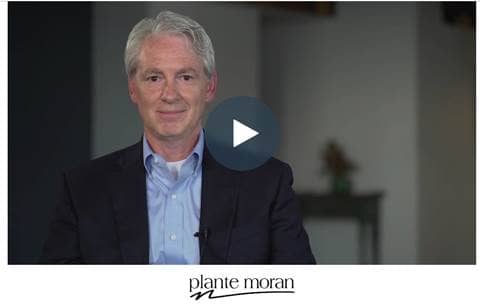As healthcare and senior living organizations grapple with rising costs, declining margins, an uncertain regulatory environment, and federal initiatives targeting efficiency in healthcare spending, many are heeding it as a warning call to evolve beyond traditional ways of doing business.
For decades, the healthcare and senior living sectors have been in a state of gradual transition, adapting to external forces that change the economics of their industry. Recent policy discussions signal a continuation of this trajectory. It’s clear that “doing nothing” isn’t an option, and a disciplined, forward-thinking approach is necessary to survive the financial and operational challenges ahead.
The importance of strategic agility
Many of today’s healthcare and senior living challenges are beyond the stage of trying to solve with yesterday’s solutions, such as mergers and acquisitions, organizationwide staff reductions, or other traditional strategies. Deeper action is critical. To survive the coming change, hospitals, health systems, and senior care providers must focus on strategic frameworks aimed at optimizing performance and transforming longer-term business models, adopting principles that will ensure effective financial and operational management isn’t just a practice, but a complete pathway to success. This journey involves two paths: optimizing near-term performance and transforming the organization to meet the future market.
Optimize your performance: Execution as a strategy
Maximizing your revenue cycle is the place to start in order to provide your organization every financial advantage possible when adapting to longer-term changes. Consider the following questions in your analysis.
- Are the payer sources you rely on effectively meeting their financial obligations? Over-dependence on nonviable payers could strain your resources without proportional benefits.
- Is there a breakdown in information flow within your organization that’s inhibiting optimal collections?
- Have you developed a plan of action to clean up the current accounts receivable aging to further identify revenue cycle opportunities?
Achieving execution excellence requires returning to basics and attending to the core values of the marketplace. Here are some actionable strategies to help fine-tune your operations.
- Performance optimization: Investigate hidden opportunities for cost-savings without sacrificing quality. Market and productivity studies, aided by data analytics and benchmarks, can shed light on efficiency gaps. Enhance your technology to help improve productivity and inform better organizational choices. Analyze your contracts and consider eliminating payer sources that aren’t economically viable.
- Financial resilience: Emphasize healthy financial ratios that can withstand disturbances. Regularly monitor your key metrics, adopt flexible forecasting, and lean on your external advisors to help develop a well-rounded financial plan for your organization.
- Accountability: Develop a culture of responsibility and flexibility. Set defined performance targets, engage in regular performance audits, and cultivate cross-functional collaboration to maintain adaptability.
Attention to detail in these strategies will help you optimize your revenue cycles, stabilize financials, and provide the foundation for your organization’s long-term survival.
Strategic transformation: Future-proofing your organization
Immediate performance upgrades, while vital, address just one component of the challenge. Most organizations face a larger, longer-term issue: transforming the business to meet the future market. This requires fundamental shifts and a comprehensive redesign of strategies that take into consideration external realities such as community needs and reimbursement trends.
Transformation demands not just restructuring but reenvisioning your organizational identity in response to industry and economic changes. Your organization may need to let go of emotional ties to existing facilities and service lines and embrace new governance structures. This shift in mindset and strategy is critical to achieving organizational strength during times of adversity.
Proactive contingency planning
Contingency planning — aimed at mitigating unexpected scenarios — is an essential first step in your journey of transformation. Your plan should include:
- Strategies to manage low-performing portfolio elements, including loss-inducing contracts and building usage.
- Scenario-based financial models tailored to various economic conditions.
- Emergency cost-saving tactics and alternative revenue avenues.
- A crisis management framework to enable swift decision-making in unpredictable scenarios.
Establishing a baseline strategy
With the contingency plan in place, the next step is to develop your strategic vision. Determine which service lines will maintain relevance and critical mass in your community. Analyze local market conditions to develop an understanding of the future landscape of healthcare and senior living in your area.
Consider how an evolving care model will influence personnel, resources, and infrastructure. Your strategy may necessitate realigning service priorities across geographic locations and sites to maximize sustainable outcomes.
Governance: Adopting a new leadership horizon
As service models evolve, a forward-looking governance structure is a necessary ingredient in your transformation. This includes leaders who embrace systemic change. Considerations for an effective governance strategy include:
- Strengthening board collaboration with active engagement in the strategic decision-making process.
- Enhancing transparency through regular financial and operational updates.
- Searching for nontraditional perspectives in leadership by recruiting executives that have demonstrated transformational success in other industries.
As these elements converge, your organization will be better prepared to meet the demands of the future industry landscape.
Finding your path forward
In the face of rapid policy, demographic, and industry evolution, healthcare and senior care organizations face momentous change not only to survive, but to create thriving organizations for the benefit of their communities. Let innovation, accountability, and transformation serve as your guide. Taking proactive steps during uncertain times can transform potential adversity into competitive advantage, making resilience a hallmark of your organization’s future success.





